Encounters Kentucky Warbler
Encounters Kentucky Warbler
This is the first of a series of short photo essays BirdCallsRadio is pleased to bring you from our guest photographer Townsend P. Dickinson.
I will share on BirdCallsRadio some images from my field work on wood warblers. My warbler work goal has been to document photographically everyday behaviors including foraging, body care, migration, sleeping, wintering and quiet spells. My plan for this series is to pick a neat bird which maybe a warbler and share photos and recollections of my close encounter.
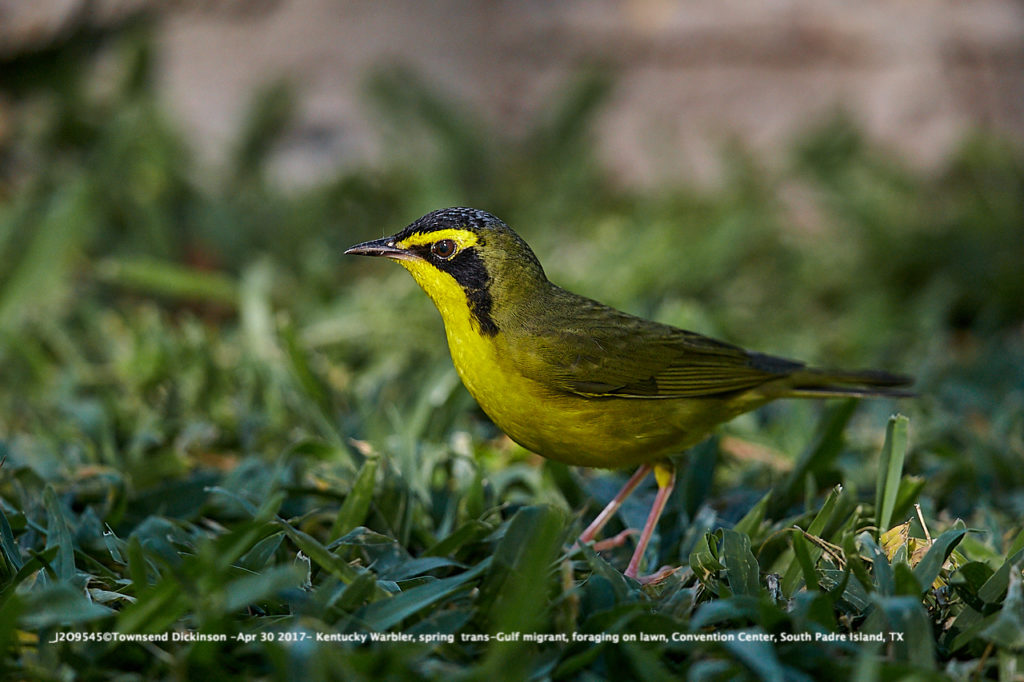
Kentucky Warbler, spring trans-Gulf migrant, foraging on lawn, Convention Center, South Padre Island, TX
I’m kicking the series off with the Kentucky Warbler. I’ve had a few noteworthy encounters with this bird over the years. In early April in the late 1980’s, I encountered a Kentucky within the brick walls of Fort Jefferson in the Dry Tortugas, Florida. I was there to photograph spring migrants in this well-known migrant trap. I had a borrowed Canon 500mm lens and had a film camera, but the rig proved frustratingly inadequate to grab a photo of the Kentucky Warbler hopping around on the ground. The warbler was oblivious to me and the dozens of birders looking at migrants all over the inner courtyard of the Fort, but the bird’s foraging habits proved too much for my equipment.
The bird would hop several feet to a likely foraging location, would forage at that location and then suddenly would hop several feet to another location. This hop, forage, hop again routine, was repeated over and over again, in what was for me, a frustrating cycle. I stalked the bird around inside the walls of the Fort and my photo cycle was move the rig, set-up the shot, focus, bird hop, and then click, too many time to count. It was a perfect ballet of move, set, focus, hop, click, I was the one out of sync. These were the days of no auto focus lens, no image stabilization either and each click cost $.50 cents for a Fuji Film ASA 100 chrome. I abandoned this opportunity when the futility became apparant, but never forgot my frustration. Many years later, as the photo from South Padre Island (see below) may attest, modern photo technology enabled me to finally catch the ground foraging Kentucky in mid hop. You simply can not imagine how pleased I was with that photo.
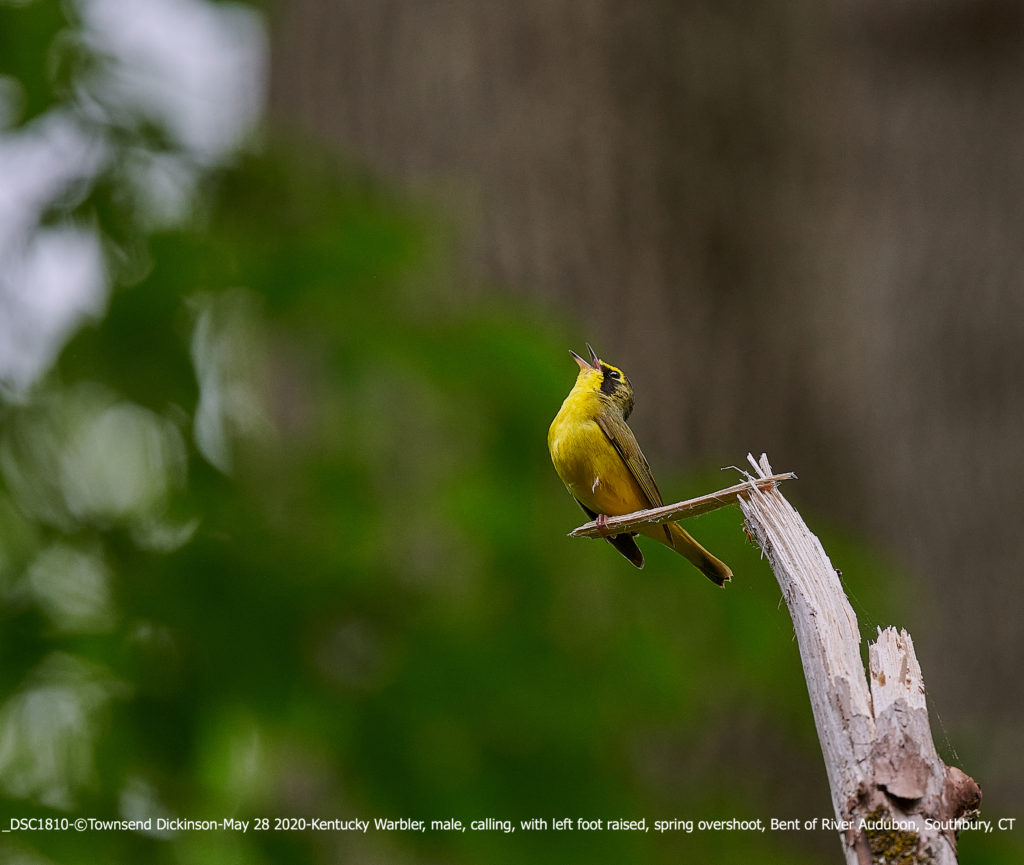
Lis#DSC1810-May 28 2020-©Townsend Dickinson- Kentucky Warbler, male, calling, with left foot raised, spring overshoot, Bent of River Audubon, Southbury, CT. All rights Reserved.
1. ⬆︎ This male Kentucky Warbler is calling in a potential breeding site, but this site is north of its current breeding range. The current breeding range extends from New Jersey west to Kansas and Oklahoma and south to Texas and back east to Florida. There appears to be gradual shift of the breeding range to the north but whether this is due to warming, a return to an ancestral breeding range or another factor is uncertain. Overshoots are how warblers can expand their breeding range. A certain number of birds, usually inexperience first year birds do overshoot breeding grounds on spring migration. Given the right circumstances, this genetic gamble, which drove this bird to migrate to this site, hoping to get lucky, may enable the Kentucky to extend it’s range today or in a hundred years. The habitat seems appropriate; all that is needed is a female. It is likely that this bird is a first year male, as most experienced birds return to scene of their last successful breeding site.
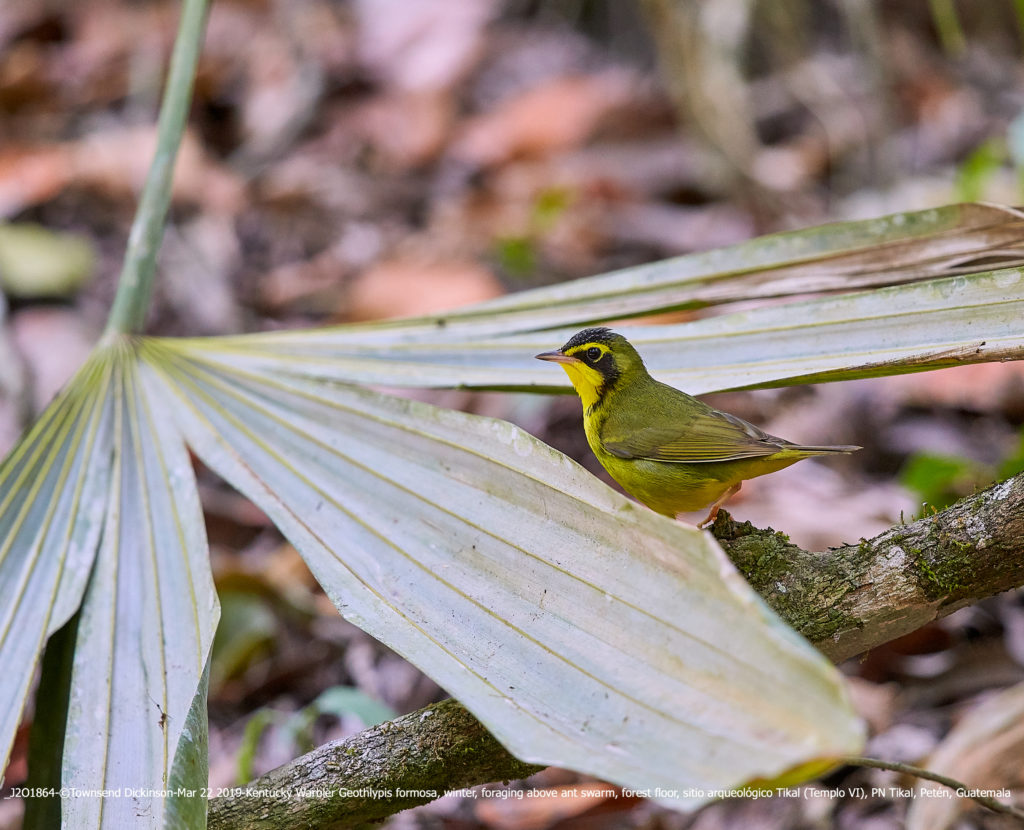
Lis#J2O1864-Mar 22 2019-©Townsend Dickinson- Kentucky Warbler Geothlypis formosa, winter, foraging above ant swarm, forest floor, sitio arqueológico Tikal (Templo VI), PN Tikal, Petén, Guatemala. All Rights Reserved.
2. ⬆︎ Kentucky Warblers usually migrate to the same location for the longer tropical portion of their life cycle. They defend these overwintering sites from other Kentucky Warblers. Here the Kentucky Warbler pauses in its fast paced foraging near a large tropical leaf on the forest floor while looking for prey. The warbler is attending an army ant swarm unseen below in the tropical forests of the Tikal Lowlands, Guatemala. This was my second sighting of a Kentucky following such an ant swarm just hours apart on the same day. The Kentucky spends an average of 6 months of it’s life here foraging low in the forest. The non-breeding range, is generally lowland tropical forests and second growth foothills from Mexico, Central America, and extending as far south as Venezuela and Colombia.
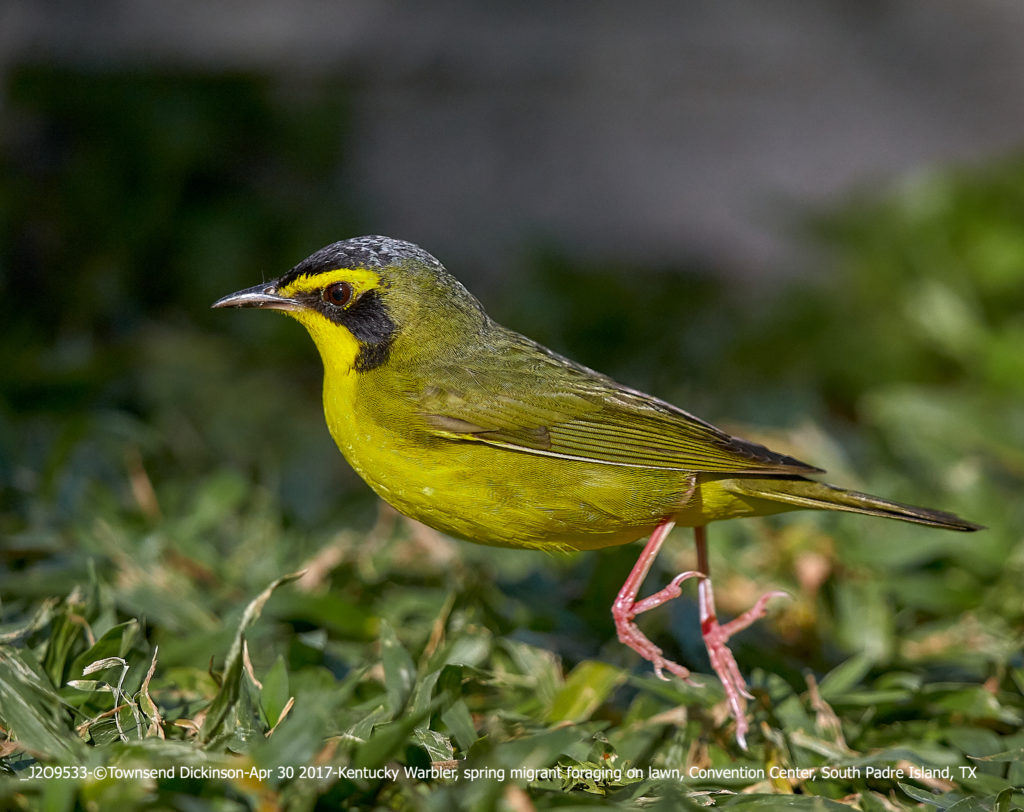
Lis# J2O9533-Apr 30 2017-©Townsend Dickinson- Kentucky Warbler, spring migrant foraging on lawn, Convention Center, South Padre Island, TX. All Rights Reserved.
3.⬆︎Do birds silently scream whoopee to themselves when they hop, I hope so? Here a Kentucky Warbler is foraging on the lawn of the Padre Island Convention Center, Padre Island, Texas. This bird is likely a trans-gulf spring migrant, and is busy foraging to replenish low fat reserves. Migrants crossing the Gulf of Mexico in the spring generally will fly well inland by daybreak, but adverse conditions ground migrants all along the Texas coast from Brownsville to High Island. I observed this bird for close to an hour as it foraged on the lawn. It foraged almost exclusively on the lawn and would hop frequently several feet to the next area of interest. I was impressed by big feet and long legs that propelled the grand hop.
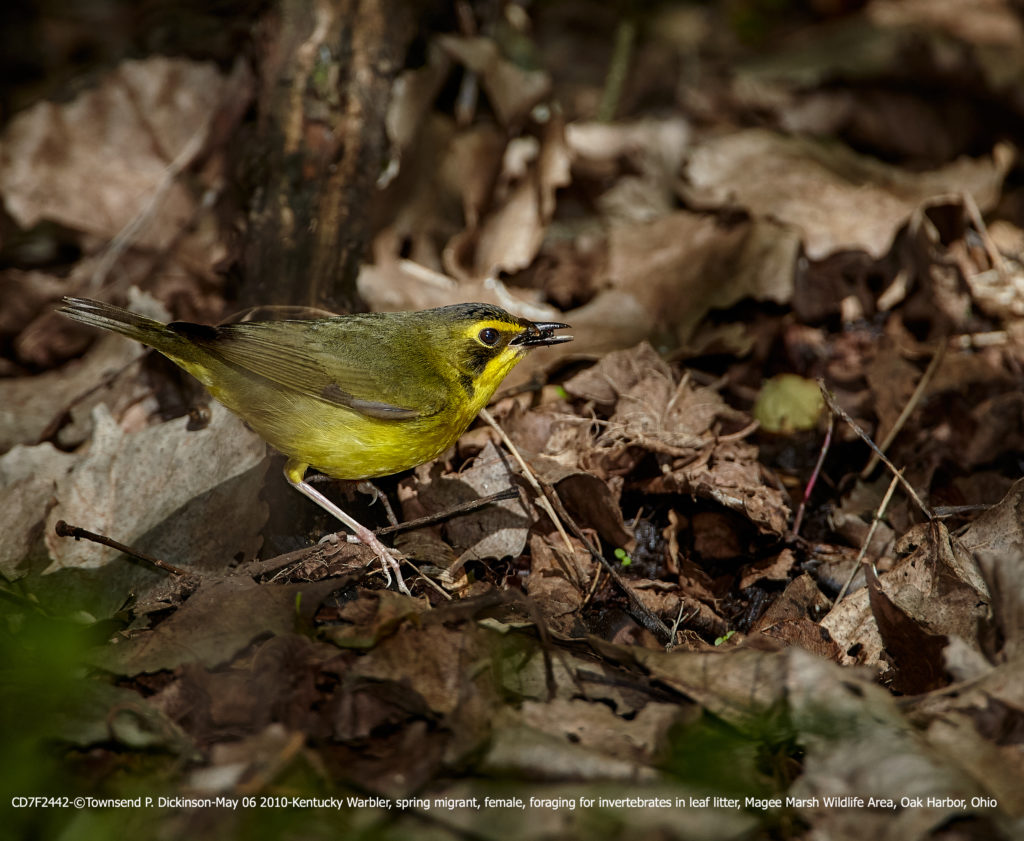
Lis# CD7F2442-May 06 2010-©Townsend P. Dickinson-Kentucky Warbler, spring migrant, female, foraging for invertebrates in leaf litter, Magee Marsh Wildlife Area, Oak Harbor, Ohio. All Rights Reserved.
4.⬆︎ This Kentucky Warbler, a female, is on spring migration too. The Magee Marsh, Ohio migrant trap provides shelter and sustenance, and she is foraging in leaves on forest floor. She has a beak full of invertebrate gathered while burrowing in and under leaves. She may be an overshoot; a sighting of Kentucky Warbler generates much excitement on the boardwalk. Most Ohio breeders are found further south, but few Kentucky Warblers do breed in southern Ontario.
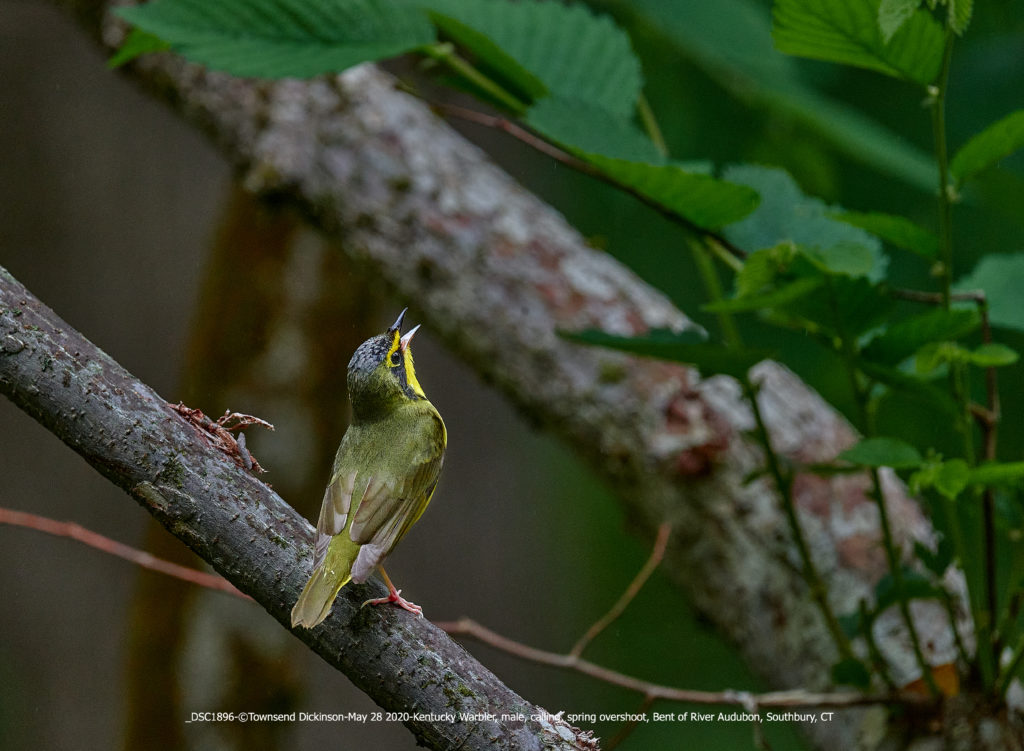
Lis#_DSC1896-May 28 2020-©Townsend Dickinson- Kentucky Warbler, male, calling, spring overshoot, Bent of River Audubon, Southbury, CT. All Rights Reserved.
5. ⬆︎ The 2020 Bent of River Kentucky Warbler called often throughout the day from various perches at this location. The loud calls from a trail in the forest just above the Bent of River, Audubon Connecticut Center Barn made it very accommodating to numerous observers. eBird shows that he was seen most days between May 24 and June 13. It was last reported on eBird June 13 so it was reported for 21 days at this site calling enthusiastically for a mate.
I will note that this bird did not seem to mind that ornithologists, using modern mtDNA data have moved it from the genus Oporonis warblers to a more suitable Genus the Geothlypis Yellowthroats. I do hope that the Connecticut Warbler does not mind being alone now. The Kentucky’s secretive nature did kind of make sense to me as an Oporonis considering how infrequently one sees a Mourning, MacGillivray’s or Connecticut during migration.
Addendum: Piping Plover Chicks Foraging
BirdCallsRadio additional information:
Support BCR DONATE NOW
Subscribe to our FREE E-Newsletter and be part of something greater. Stay up to date on all our episodes and exclusive offers by scrolling to the bottom and sign up with your email. All emails are confidential.


Wonderful pictures!
Thank you John. Great to hear from you! I have passed this onto TPD.